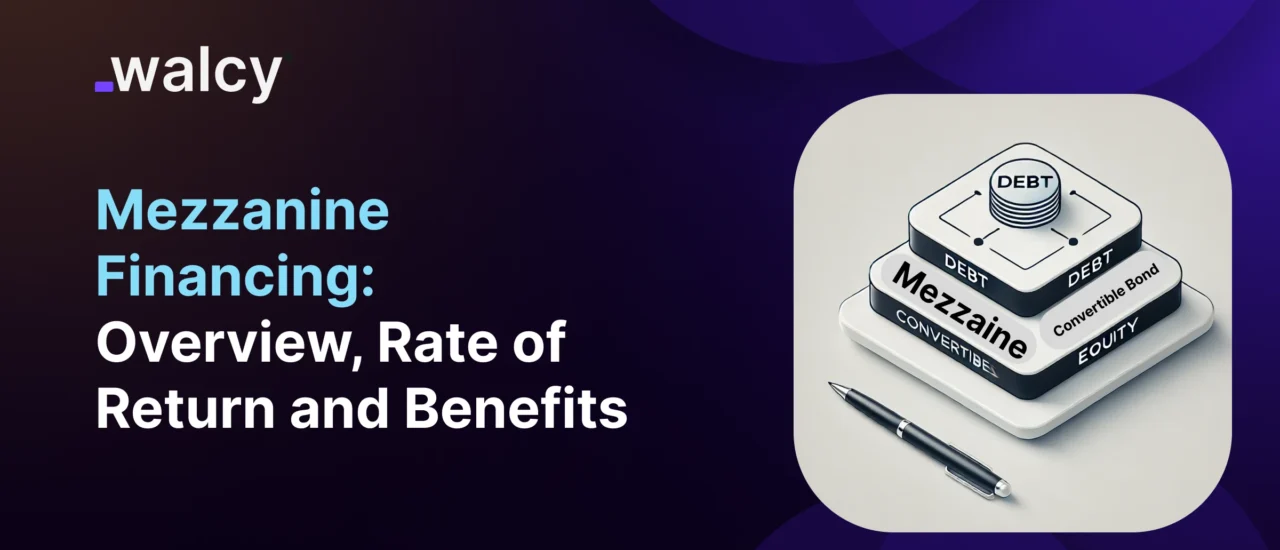Mezzanine financing is a source of finance that falls between conventional debt and equity in the firm’s capital structure.
It is mainly utilized for business expansion or acquisition purposes whereby the business entity has already used other sources of finance such as senior debt.
This type of finance is highly flexible and, due to its subordination to senior debt, is often considered riskier for the lender than other forms of finance.
As a result of this increased risk, mezzanine lenders will normally have higher interest rates; they can also receive equity-based rewards.
This blog will provide an overview of mezzanine financing, how it works, and the main differences between mezzanine debt and other kinds of financing, such as subordinated debt and preferred equity.
Drawing on real-life examples, the paper will examine some of its advantages and disadvantages and discuss its place both within small businesses and growing companies.
What is Mezzanine Financing?
Mezzanine finance is a hybrid capital source, having debt and equity characteristics.
Companies utilize the facility when they require substantial increases in capital but perhaps without either collateral or creditworthiness to support bank demands for more traditional loans.
While mezzanine finance takes the legal form of a loan, it may also embed some equity-like features, such as warrants, options, or even conversion rights.
Mezzanine financing generally holds a position in the capital structure between senior debt, which has claims to assets, and equity financing.
The implication of this is that the facility stands to be riskier than those of senior debts since its repayment comes after that of senior creditors when bankruptcy or liquidation takes place.
On the other hand, it can also provide investors with higher returns compared to what may be possible with senior debt as it is usually higher in interest rate and in combination with fixed repayment schedules.
Read about: What is Recurring Billing? Key Benefits Explained
Characteristics of Mezzanine Financing
- Subordinated Debt:
By nature, mezzanine financing is a subordinated debt, hence ranking below senior debt but above equity in a firm’s capital structure. In cases of bankruptcy or liquidation, mezzanine lenders are paid after senior debt holders but before equity investors.
- Higher Interest Rates:
Since mezzanine debt ranks lower than senior debt, the interest rates should be higher against senior debt. The average usually ranges from 12% to 20% or more, depending on the level of the involved risk.
- Equity Kickers:
With the greater credit risk involved, mezzanine lenders are typically given an “equity kicker” or warrant. This allows them to purchase equity in the business at some later date and provides the lender with an opportunity to share in business growth.
- Flexible Terms:
Mezzanine loans have flexible terms that allow companies more leeway when it comes to paying back their loans.This includes allowing the payment of interest for certain periods or “payment-in-kind”, where interest adds to the loan balance and does not necessarily constitute cash payments.
- Unsecured or Semi-Secured:
Mezzanine financing is almost always unsecured, although there are semi-secured mezzanine loans; these are supported by subordinated collateral that stands lower in priority compared to senior debt.
Read about: Startup Business Loans in India: Which is the Best?
Mezzanine Finance vs. Subordinated Debt
While both mezzanine finance and subordinated debt represent the type of non-senior finance, they still have several significant factors that can distinguish one from another.
Subordination:
It describes debt that ranks below the senior debt but above equity. Mezzanine debt is riskier and quite often contains both debt- and equity-like features, including warrants or options.
Risk and Return:
Mezzanine financing is riskier compared with subordinate debt as it is convertible to equity apart from offering higher interest rates. Mezzanine debt promises significantly higher returns, with equity kickers and more substantive rates of interest.
Flexibility:
The terms of the subordinated debt repayment are less flexible in comparison with mezzanine debt. In mezzanine financing, other options may prevail: PIK interest and warrants offering upside to the investor. Interest rates are generally lower too.
Mezzanine Financing vs Preferred Equity
Mezzanine financing and preferred equity are virtually the same during discussions; this is because they usually share similar characteristics, in that they advance companies with additional capital against higher return.
In structure, however, they vary.
Structure:
Mezzanine financing is a debt; therefore, it is due to be repaid, commonly with interest. On the other hand, preferred equity is a sort of equity; hence, investors will be paid a fixed dividend, although they will not be reimbursed.
Control/Ownership:
For example, the mezzanine lenders may have warrants or other equity kickers but are not considered owners unless the debt is converted to equity.
Conversely, preferred equity owners do have a right to dividends but are not considered in control of the entity unless some event or milestone is met that allows their ownership to become controlling.
Risk:
Preferred equity is generally riskier to the investor than mezzanine debt. Equity investors have a residual claim on assets, meaning they are paid only after all of the debt holders have been satisfied.
At the same time, mezzanine debt is generally more secure in its repayment stage because it remains a loan even if subordinated.
How does mezzanine financing work?
Generally, mezzanine financing is representative of a mixture of debt and equity. A firm may approach a mezzanine financing provider in cases where its capital is needed for expansion, acquisition, or restructuring of the balance sheet.
The financing provider would underwrite the financials, business model, and growth prospects of the company against the loan to be given. The process generally goes through:
- The company seeking mezzanine financing submits an extremely detailed business plan to a mezzanine lender. It focuses on the financials and growth forecasts.
- The terms of the loan would have been agreed upon previously, but the interest rate, the schedule for the repayment of the loan, and whether the lender is going to get equity kickers or warrants would be subject to negotiation. Another type of mezzanine loan could be one in which PIK interest is paid, whereby interest payments would be postponed.
- The disbursement funding is issued to the company upon agreement of terms by the lender. Normally disbursed in one amount, funds may be divided into staged payments depending on project completion.
- The Company starts the loan repayment and usually does so in a tenure ranging from 5-7 years. Sometimes, a balloon payment is included at the end of the period of the loan with the whole principal being paid.
Read about: What is Fund Disbursement? Definition, Types and Importance.
Mezzanine Financing for Small Business
The general problem that usually accompanies small businesses involves their access to capital. They normally lack adequate credit history or assets that may turn into conventional loans.
This is where mezzanine financing comes in and fills the gap because it provides capital that will not need any collateral. This would be especially appealing to small businesses wanting to expand or acquire other companies or refinance their debt.
Mezzanine financing is a kind of deal that combines debt with other equity features whereby the company agrees to repay the loan in installments, usually with an option to postpone the payment of interest during poor performance or to convert debt into equity in case it has performed super well.
Besides expansion and improvement, a mezzanine can be employed to provide working capital, buy new equipment, hire new workers, or finance mergers or acquisitions.
Read about: Expanding Business Internationally: Must Know Things
Advantages of Mezzanine Financing
- Flexible Capital Structure:
Unlike other forms of financing, mezzanine financing never burdens a company with more senior debt; therefore, it allows flexibility in the capital structure.
- Retention of Ownership:
Unlike equity financing, there is no need to give away a substantial portion of ownership in the enterprise through mezzanine financing. The control stays in-house, although the lender has conversion rights.
- Speedier Access to Capital:
Mezzanine financing is, in reality, faster compared to any form of traditional bank loaner equity financing. As such, it becomes one of the helpful tools a company can use when it needs speed either in expansion or acquisition.
- Growth Potential:
In that mezzanine financing is mainly used for the expansion of a business or to acquire another, this aids in growth. More growth is crucial for the building of market share and, therefore, driving returns for the business and the investor.
- Higher Return to Lenders:
Mezzanine lenders realize higher returns than senior lenders apart from realizing equity-like returns through warrants or conversion rights.
Disadvantages of Mezzanine Financing
- It is More Expensive:
Because mezzanine financing generally holds a greater interest rate due to the riskier position in the capital structure, it tends to be more expensive than other forms of financing.
- It can be Dilutive:
This occurs because the loan has equity conversion features, and there may be some dilution to the existing shareholders of the company.
- Repayments Pressure:
Mezzanine loans are flexible; however, the repayments will equally strain the enterprise considering the nature of cash flows which may not be enough to meet the needs of a loan.
- Complexity:
In its structuring, the mezzanine financing is usually complex with the negotiations over terms, covenants, and equity kickers being entangled.
Read about: International Money Transfer Charges | How Much Does It Cost?
Example of Mezzanine Financing
A company wants to buy a smaller rival. It goes to a mezzanine lender for $10 million financing.
Those could be the terms: a 14% interest rate, not having to pay the interest payments for two years, and a set of warrants to buy into equity in the company at a later date.
This money is advanced by the mezzanine lender, and the company uses the capital to complete the acquisition.
Over the succeeding years, the company grows significantly and provides returns not only in the buy but also in value addition through mezzanine financing.
The lender wins with higher interest rates and upside via equity warrants and the company achieves its strategic objectives without losing control.
Read about: Top 10 Wealth Management Firms in India.
Conclusion
Mezzanine is a very powerful tool of growth capital for companies wherein the more conventional options of debt are not available.
On the other hand, mezzanine financing tends to be more expensive and considered riskier than senior debt. Flexibility and added resources can indeed propel expansion, acquisition, and other growth opportunities.
For the investor of mezzanine financing, returns by way of interest and equity kickers may be very high. The Mezzanine, therefore, conveys a special niche within the realm of private capital.
The present paper, therefore, hopes to throw some light on the critical attributes, advantages, and risks associated with mezzanine financing and go a long way in helping companies and investors decide whether this is the right solution.
Be it a small business seeking expansion or a bigger firm contemplating making a strategic acquisition, mezzanine financing can play a vital role in achieving financial and operational goals.
Do follow us on Facebook and LinkedIn, to stay connected with us.



